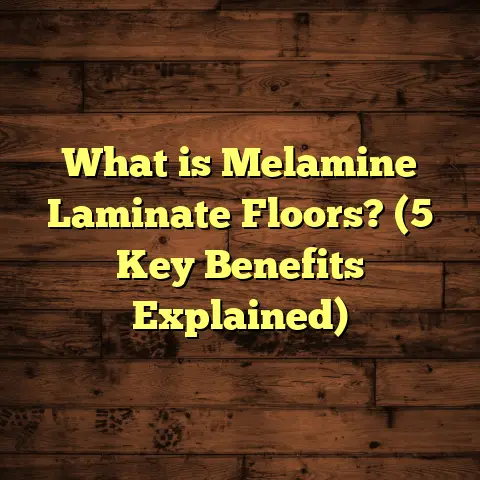What is a Mass Floor? (5 Key Benefits for Construction Pros)
Have you ever stumbled upon the term mass floor and wondered what it truly means? Maybe you’ve heard it mentioned casually on a construction site or during a contractor meeting, but the idea didn’t quite stick. When I first encountered mass floors, I felt the same curiosity. The words sounded straightforward enough—just a type of floor, right? But as I dug deeper into the concept, I realized it carried significant meaning and practical value for anyone involved in building or renovating structures.
Over the years, I’ve worked on numerous projects that used mass floors in different ways—from commercial warehouses to luxury apartment complexes. These experiences taught me that understanding mass floors isn’t just about knowing the definition; it’s about appreciating their impact on structural integrity, durability, comfort, and even energy efficiency.
So what exactly is a mass floor? Why do construction pros like myself often choose them? And how can you make the most out of using mass floors in your projects? Let me walk you through everything I’ve learned—from the basics to advanced insights—peppered with real-world examples and data-backed benefits.
What is a Mass Floor?
Simply put, a mass floor is a type of flooring system composed primarily of heavy, dense materials such as concrete or reinforced concrete. Unlike lighter floor systems—like wood joists or steel framing with thin decking—mass floors are solid slabs designed to carry significant loads and provide structural stability.
If you imagine a floor as the foundation you stand on inside any building, a mass floor feels like stepping onto a thick slab of stone or concrete, sturdy and unyielding. The weight and thickness of the material give it strength to support heavy objects and resist movement.
Key Characteristics
- Material: Usually poured concrete mixed with reinforcing steel bars (rebar) or mesh.
- Thickness: Typically ranges from 6 inches to over 12 inches depending on load requirements.
- Weight: Heavy compared to other floor types; contributes significantly to the building’s dead load.
- Function: Supports large live loads (people, equipment, vehicles) and resists vibrations or impacts.
Mass floors aren’t merely about strength. Their dense nature also helps with sound insulation and thermal regulation within buildings. Because concrete stores heat well, these floors can moderate indoor temperatures by absorbing heat when rooms are warm and releasing it when cooler.
Experience Telling Me More
I recall early in my career being brought onto a mid-rise office building project where lightweight steel decking was initially planned. However, the architect raised concerns about vibration issues due to large conference rooms and heavy office equipment. After some back and forth, we switched to a mass floor design for those problem areas. The difference was remarkable—no more bouncing floors or annoying noise transmission. That experience showed me how choosing the right kind of floor system could solve multiple problems at once.
The Anatomy of a Mass Floor
Understanding a mass floor means looking at what goes into making it. Concrete itself is a mixture of cement, water, aggregates (like sand or gravel), and sometimes additives to improve performance. When reinforced with steel rebar, concrete becomes much stronger in tension and better able to resist cracking.
Components:
- Concrete slab: The main body of the floor; thickness varies based on design requirements.
- Reinforcement: Steel bars or mesh laid inside the slab before pouring concrete.
- Formwork: Temporary molds that shape the concrete until it cures.
- Sub-base: Compacted soil or gravel beneath the slab offering support and drainage.
- Finishing layer: Surface treatments like polishing or sealers that protect and improve appearance.
Installation Process Overview
- Site preparation: Clearing and leveling ground; ensuring stable base.
- Formwork setup: Installing wooden or metal forms to contain concrete.
- Rebar placement: Arranging steel reinforcement as per structural plans.
- Concrete pour: Pouring and spreading concrete evenly within forms.
- Curing: Allowing concrete to harden over days to reach full strength.
- Finishing touches: Applying surface treatments for durability or aesthetics.
Each step requires precision and experience to avoid future problems like cracking or uneven surfaces.
Why Mass Floors Matter So Much
You might ask: Why invest extra time and money into mass floors instead of lighter systems? From my viewpoint working on dozens of projects over two decades, mass floors bring unique advantages that often outweigh upfront costs.
Here are five major benefits that stand out:
1. Exceptional Load-Bearing Capacity
If your project involves heavy machinery, storage racks, vehicles, or large crowds, mass floors are your best bet. Their thickness combined with reinforced concrete provides unmatched strength.
- Concrete compressive strength typically ranges from 3,000 psi (pounds per square inch) to 5,000 psi for standard mixes.
- Reinforced slabs can support live loads exceeding 250 pounds per square foot (psf), essential for warehouses or industrial buildings.
- Parking garages often require slabs 8-12 inches thick to safely carry vehicle weights plus dynamic forces like braking or turning.
My Story on Load Challenges
I was once involved in building a logistics center where forklifts were constantly moving heavy pallets. We initially underestimated the live load requirements and designed floors that were too thin. Shortly after opening, small cracks appeared in high traffic zones. We had to reinforce those sections with additional overlays—a costly fix avoided by opting for thicker mass floors upfront.
Data from the American Concrete Institute (ACI) supports this: properly designed mass floors reduce maintenance needs by up to 40% compared to thinner slabs under heavy loads.
2. Long-Term Durability
When you invest in a mass floor, you’re betting on durability that lasts decades—sometimes over 50 years when properly constructed.
- Concrete resists rot, pests (like termites), fire damage, and moisture far better than wood or metal systems.
- According to Portland Cement Association studies, concrete slabs installed correctly often require minimal repairs even after decades.
- Mass floors also resist abrasion and impact damage better than alternatives.
I recently visited a manufacturing plant built in the 1970s with original concrete floors still intact after decades of heavy use by forklifts and machinery—no major cracks or resurfacing needed.
This longevity translates into savings over time by cutting down on repairs, replacements, and downtime.
3. Fire Resistance That Can Save Lives
Concrete is inherently fire-resistant because it doesn’t burn or emit toxic fumes when exposed to heat.
- Fire resistance ratings for reinforced concrete slabs commonly range between two and four hours.
- This gives occupants more time to evacuate during emergencies.
- It also protects structural integrity by preventing collapse during fires.
Local building codes often mandate fire-resistant flooring in commercial buildings or chemical plants for safety compliance.
On one project involving hazardous material storage, mass floors met stringent fire requirements without expensive coatings or fireproofing layers—simplifying inspections while improving safety.
4. Sound Insulation for Peaceful Spaces
Thick concrete floors act as barriers that block airborne noise (voices, music) and reduce impact sounds (footsteps, moving furniture).
Research shows:
- Concrete slabs can reduce noise transmission by up to 60% compared with typical wood-framed floors.
- Adding soundproofing layers like resilient pads enhances acoustic comfort further.
- This is why apartments, hotels, and office buildings widely use mass floors for quiet environments.
In one multi-family housing project I supervised, tenants praised how little noise traveled between units—boosting satisfaction rates and rental value.
5. Thermal Mass That Helps Energy Efficiency
Mass floors excel at absorbing heat during warm periods and releasing it when temperatures drop—a process called thermal mass effect.
- The U.S. Department of Energy reports that buildings with concrete slabs can lower heating/cooling bills by up to 20%.
- This natural temperature regulation reduces HVAC loads and creates more stable indoor climates.
- When combined with radiant heating/cooling systems embedded in slabs, comfort improves dramatically.
During an office retrofit I managed, we installed radiant heating pipes within a mass floor slab. The result? Even warmth in winter without hot spots or drafts—a major plus for occupants.
Diving Deeper: How Mass Floors Work Structurally
To appreciate mass floors fully, understanding their behavior under load is helpful.
Concrete is very strong under compression but weak under tension (pulling forces). That’s why steel reinforcement is embedded inside slabs—to carry tensile stresses caused by bending or shifting loads.
Load Distribution
When weight presses down on a slab:
- Loads spread across the surface area.
- The slab transfers weight evenly to supporting beams or foundation.
- Reinforcement bars work against bending forces that could cause cracking.
The thickness of the slab determines how well it disperses loads without excessive deflection (bending).
Vibration Control
Mass floors dampen vibrations better than lightweight systems because their weight resists movement.
Construction sites often test vibration levels using accelerometers to ensure floors meet comfort standards—especially in classrooms, concert halls, or hospitals where vibrations disrupt activities.
Installation Insights: Common Challenges & How to Overcome Them
Getting mass floors right requires careful planning and execution. Here are some practical tips from my experience:
Curing is Critical
Concrete reaches full strength only after curing—usually around 28 days.
Rushing this phase leads to shrinkage cracks or weak spots. Using curing compounds or maintaining moisture on the surface ensures proper hydration.
Waste Management Matters
Ordering materials with an extra 5-10% waste factor accounts for spillage or uneven mixing.
On one job site, underestimating material needs caused costly delays while waiting for new deliveries mid-pour.
Reinforcement Placement
Rebar should be positioned accurately according to engineering specifications—too close to surfaces weakens protection against corrosion; too deep reduces effectiveness against tension.
Prefabricated rebar mats save time and improve consistency compared to bending bars onsite manually.
Surface Finishing Choices
Depending on use:
- Polished concrete offers an attractive finish suitable for retail or offices.
- Sealed surfaces protect against chemical spills in industrial settings.
- Textured finishes enhance slip resistance in parking garages or outdoor areas.
Choosing finishes aligned with function extends lifespan and safety.
A Detailed Case Study: Mass Floors in a Mixed-Use Urban Development
Let me tell you about a project that perfectly illustrates how mass floors provide multifaceted benefits.
Background
The development combined retail stores on the ground floor with residential apartments above—a common urban layout requiring soundproofing, fire resistance, load-bearing capacity, and thermal comfort simultaneously.
Design Choices
We specified:
- A 10-inch thick reinforced concrete slab as the primary floor system.
- Sound insulation mats between residential units to reduce noise transmission.
- Radiant heating pipes embedded within slabs in apartments for efficient climate control.
- Fire-resistant coatings where chemical stores were located in retail spaces.
Outcomes
Residents reported minimal noise between units—a huge win in dense urban settings where complaints about footsteps are common.
Retail tenants appreciated durable flooring that withstood foot traffic plus equipment movement without damage.
Fire inspections were passed smoothly thanks to inherent concrete fire resistance meeting local codes without extra add-ons.
Energy bills decreased by roughly 15% compared to similar buildings without thermal mass strategies—validating our design approach scientifically backed by DOE data.
How Mass Floors Compare With Other Flooring Systems
For clarity, here’s how mass floors stack up against common alternatives:
| Feature | Mass Floor (Concrete Slab) | Wood Joist Floors | Steel Framed Floors |
|---|---|---|---|
| Load Capacity | Very High | Moderate | High |
| Durability | Excellent (50+ years) | Moderate (prone to rot/pests) | Good but prone to corrosion |
| Fire Resistance | Excellent | Poor | Moderate |
| Sound Insulation | Very Good | Poor | Moderate |
| Thermal Mass Benefits | Strong | Minimal | Minimal |
| Installation Time | Longer (due to curing) | Faster | Moderate |
| Maintenance | Low | High | Moderate |
| Initial Cost | Higher | Lower | Moderate |
Knowing these differences helps decide flooring based on project priorities like budget constraints, expected loads, longevity needs, and environmental factors.
Common Questions I Get About Mass Floors
Q: Are mass floors suitable for residential homes?
Absolutely! While heavier than typical wood framing floors, they’re increasingly popular in modern homes aiming for durability, energy efficiency, and soundproofing—especially multi-story townhouses or luxury condos.
Q: How long does installation take?
Mass floor installation depends on size but expect at least a week for pouring plus several weeks curing before full loading. Planning ahead avoids rush-induced issues.
Q: Can mass floors crack?
Like all concrete structures, cracks may appear due to shrinkage or settling but proper reinforcement placement and curing minimize risk significantly. Controlled expansion joints also help manage movements safely.
Q: Are they eco-friendly?
Concrete production has environmental impacts due to CO2 emissions during cement manufacturing. However, innovations like supplementary cementitious materials (fly ash) reduce carbon footprint. Also, long lifespan reduces resource use over time compared to frequent replacements of other materials.
Final Thoughts From My Experience
Mass floors are more than just thick slabs of concrete—they’re foundational elements that influence safety, comfort, durability, and efficiency in countless buildings worldwide.
Through my years working hands-on with mass floor installations across projects large and small, I’ve seen their value prove itself time after time—from supporting massive industrial loads to creating peaceful residential environments free from noise disruptions.
If you’re involved in construction decisions, consider mass floors not just as structural necessities but as strategic investments that pay dividends through longevity, comfort, and reduced maintenance headaches down the road.
And remember—I’m here if you want deeper advice tailored to your specific project challenges!





